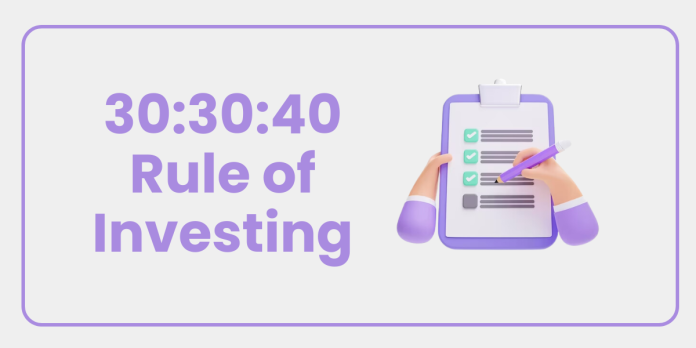Two friends sat down at a cozy coffee shop, sipping their lattes and discussing their plans for the future. Rohit, a financial enthusiast, had a gleam in his eye as he leaned in to share a financial secret with his friend, Kiran.
“Kiran,” he said with a grin, “imagine if you could achieve financial independence in just 15 years.”
Kiran raised an eyebrow, intrigued. “That sounds too good to be true, Rohit. How on earth could one achieve that?”
Rohit leaned back, looking thoughtful. “It’s all about the 30:30:40 rule of investing.”
“The what now?” Kiran asked, her curiosity piqued.
“The 30:30:40 rule,” Rohit repeated. “It’s a simple formula that, if followed diligently, can help you become financially independent in 15 years. Let me break it down for you.”
Rohit took out a pen and napkin and started scribbling down the numbers.
“Imagine you earn a monthly salary of Rs 75,000,” he began. “According to the 30:30:40 rule, here’s how you should allocate your income:
- 30% of your salary, which is Rs 22,500, should be designated for your monthly expenses.
- Another 30%, also Rs 22,500, should be the maximum you spend on EMIs if you have any.
- The remaining 40%, which is Rs 30,000, should be invested.”
Kiran nodded, starting to see where Rohit was going with this.
“But what if I don’t have any EMIs to pay?” she asked.
“Great question,” Rohit replied. “If you don’t have any EMIs, then you should channel that extra 30% into investments as well. The key is to maximize your investments rather than increasing your expenses.”
Kiran was beginning to grasp the concept, and Rohit continued with the math.
“Now, let’s consider what happens over 15 years if you stick to this plan. Assuming an inflation rate of 6%, your monthly expenses will grow to roughly Rs 54,200 in 15 years.”
Kiran followed along as Rohit explained further, “If you invest the remaining 40%, which is Rs 30,000, every month and expect a 12% annual return on your investments, you will have a corpus of approximately Rs 1.51 crore in 15 years.”
“That’s impressive,” Kiran exclaimed. “But what do I do with that corpus once I’ve accumulated it?”
Rohit smiled. “You can use a conservative estimate of 4.3% annual return on your corpus. With that, you can generate Rs 54,200 per month without depleting your initial investment.”
Kiran was starting to see the magic of the 30:30:40 rule. “So, you’re saying that by following this plan, I can largely take care of my living expenses in 15 years?”
Rohit nodded. “Exactly, Kiran. The objective of this rule isn’t to encourage you to retire in 15 years necessarily. It’s about gaining confidence that your basic expenses can be taken care of through simple investing. Of course, there are other financial goals and lifestyle inflation to consider, which may vary from person to person. This plan focuses on securing your living expenses and financial freedom.”
As Kiran absorbed this information, she couldn’t help but feel empowered. The 30:30:40 rule of investing offered a clear path towards financial independence, giving her the freedom to pursue her dreams and ambitions without the burden of financial worries.
Read:- Investing To Build A Secure Financial Future
In conclusion, while achieving complete retirement might require more planning and consideration, this rule serves as a blueprint for securing your basic needs and enjoying peace of mind. By following the 30:30:40 rule and embracing the power of compounding, you can take significant strides toward a financially independent future.
Disclaimer: This blog has been written exclusively for educational purposes. The securities mentioned are only examples and not recommendations. It is based on several secondary sources on the internet and is subject to changes. Please consult an expert before making related decisions.


